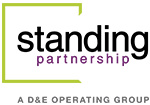Building Organizational Resilience with Horizon Scanning
Learn how horizon scanning helps organizations detect emerging risks early, enabling proactive strategies that strengthen resilience and support smarter, forward-looking decision-making.
 A Conversation with Mihaela Grad, Senior Vice President, Head of Standing Partnership’s Risk & Resilience Practice
A Conversation with Mihaela Grad, Senior Vice President, Head of Standing Partnership’s Risk & Resilience Practice
In a world where uncertainty is the only constant, organizations must evolve beyond reactive risk management. Mihaela Grad discusses how companies can shift from playing defense to building resilient, forward-looking strategies through horizon scanning.
Q: What exactly is horizon scanning, and how does it differ from traditional issues management?
Mihaela Grad: Horizon scanning is a systematic process for identifying early-stage risks—often called weak signals—analyzing their potential impact and prioritizing which ones to address before they escalate. Unlike traditional issues management, which often reacts to issues happening today, horizon scanning helps organizations spot emerging issues early.
Q: How is horizon scanning different from monitoring programs?
Mihaela Grad: Even the most comprehensive monitoring program in the world will not tell your organization how to assess the potential of emerging risks or what to do to prepare. Horizon scanning is about spotting risks, analyzing the ways in which they might impact your organization and then deciding what to do about them – assigning responsibility to teams and allocating resources accordingly.
Q: Why should enterprises invest in horizon scanning?
Mihaela Grad: Because it transforms how they manage risks—from “whack-a-mole” firefighting to strategic foresight. Many organizations are caught off-guard by issues because they lack the infrastructure to assess early signals. Horizon scanning creates a disciplined, cross-functional process for detecting, validating, and responding to potential threats. Leaders gain not just situational awareness, but also the agility to act before issues explode. It enhances internal transparency, enables smarter decision-making, and, ultimately, strengthens organizational resilience.
Q: How does the horizon scanning process work?
Mihaela Grad: Horizon scanning consists of a process carried out by a dedicated cross-functional group that is enabled by technology. It unfolds in three main steps:
- Collect: We gather information from both internal and external resources. Internally, this could include insights from regulatory, HR, legal, sustainability, and investor relations teams, as well as employee feedback. We also rely on external monitoring platforms such as AlphaSense, Meltwater, etc.
- Assess: In collaboration with our clients and with the help of AI research tools, we make sense of these signals to build context, identify themes, and consider their potential implications across regulatory, reputational, legal, environmental, and societal dimensions.
- Rank: We help our clients build dedicated cross-functional teams of leaders who evaluate the risks, prioritize them and assign responsibility and resources for their mitigation.
This cycle is designed to be ongoing, integrating new data and evolving insights with consistency and rigor.

Q: Where is horizon scanning headed next?
Mihaela Grad: We’re entering a phase of AI-augmented foresight. This means leveraging large language models (LLMs) to expand our risk foresight capabilities and testing AI-enhanced predictive insights to improve signal detection, sentiment tracking, and regulatory trend monitoring.
For more on how your organization can implement a horizon scanning framework and boost risk intelligence, reach out to us at inquiries@standingpartnership.com.
